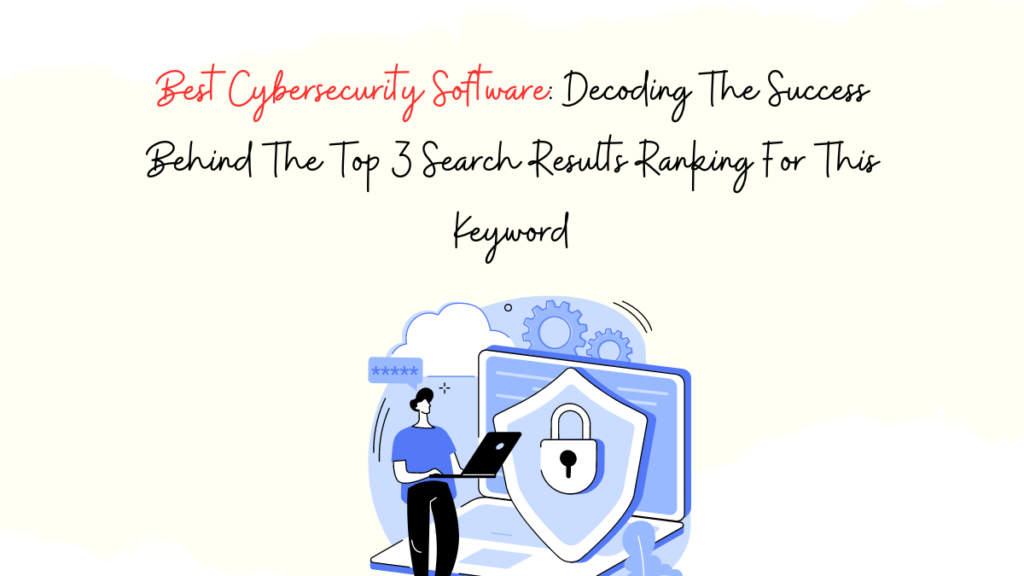Are you struggling to rank your website on the top of Google’s search results for “best cybersecurity software”?
Do you find yourself questioning why your competitors consistently outrank you?
Are you tired of seeing your content fall short of driving the traffic and conversions you need?
These questions are all too familiar to SEO professionals and website owners.
Ranking high on search engine results pages (SERPs) is more than a vanity metric; it’s a crucial element that can significantly impact your online visibility, traffic, and business success.
This is why a thorough SERP analysis is essential.
SERP analysis goes beyond basic keyword research; it involves understanding why top-ranking pages perform well and what makes them stand out.
This is what we are going to do in this article. We are going to dissect the top 3 search results for the ‘best cybersecurity software’ keyword. We are going to analyze them based on the following:
- Does their content align with the searcher’s intent?
- Does their content communicate the key message directly without unnecessary details?
- Does their article’s introduction effectively address the audience’s primary concerns or questions?
- Does their content establish credibility and persuasiveness through the use of data, statistics, or case studies?
- Does their content encourage further action, which is crucial for lead generation?
- Is their content optimized for search engines beyond just keyword use?
By evaluating these factors, you will be able to understand the strategies that drive their success and implement the same for your website.
Let’s start with the 1st article for The CTO Club
1. 25 Best Cybersecurity Software Reviewed For 2024 (by TheCTOClub)
Intent Alignment
TheCTOClub’s article targets readers seeking comprehensive reviews of cybersecurity software. The article’s intent is informational and aimed at educating the audience about various tools available in the market. It effectively aligns with this intent by presenting a listicle format that offers detailed reviews of each tool.
The article begins with a “QUICK SUMMARY” that states:
These lines immediately align with the informational intent, setting the stage for a detailed exploration of software options.
The article goes further to offer a solution by providing detailed guidelines on how to make these decisions thoughtfully and strategically in a segment titled “How to Choose a Cybersecurity Software.”
This segment offers a structured approach to decision-making, advising readers to consider the problems they are solving, who will use the software and compatibility with existing tools.
Clarity and Conciseness
The article maintains clarity by using simple language and concise paragraphs. Each software review is structured in a way that highlights key features and benefits without overwhelming the reader.
Each tool review follows a similar format, starting with why the software was picked, standout features, integrations, and pros and cons. For instance, the review of New Relic includes:
This structure, along with short paragraphs and bullet points, ensures clarity and allows readers to skim the content easily.
It also includes a “Best Cybersecurity Software Shortlist” section where each tool is categorized by its best use case, such as:
This approach makes it easier for readers to identify the right software for their particular challenges.
Pain Point Addressal in Introduction
The article effectively addresses the reader’s primary pain points right at the beginning by acknowledging the complexity of choosing cybersecurity software. It promises a solution by presenting a curated list of top tools.
Within the first few sentences, the article states:
This acknowledgment of the reader’s challenge is followed by the assurance that the list will simplify their decision-making process, directly addressing the audience’s primary concern.
Use of Evidence and Data
The article establishes credibility by using data, and expert reviews to support its claims. This approach not only adds authority to the content but also persuades the reader by providing concrete evidence.
The article mentions:
Such data points enhance the article’s persuasiveness and trustworthiness. It also outlines the detailed criteria used for selection, emphasizing the fairness and consistency of the evaluation process:
Call-to-Action Placement and Effectiveness
The article includes strategically placed calls-to-action (CTAs) that guide the reader toward further engagement. These CTAs are relevant and seamlessly integrated into the content, encouraging users to take the next step.
Throughout the article, there are CTAs like:
These prompts encourage readers to explore more detailed information or seek personalized guidance, making them effective for lead generation without interrupting the flow of information.
SEO and Technical Optimization
TheCTOClub’s article is well-optimized for search engines beyond just keyword usage. It incorporates several technical SEO strategies to enhance its visibility and ranking on SERPs.
The article features a structured layout with clear headings, such as “Best Cybersecurity Software Summary” and “Why Trust Our Cybersecurity Software Reviews?” It includes both internal and external links, such as:
These links enhance its SEO profile by connecting readers to relevant resources and maintaining engagement on the site.
Additionally, the article’s mobile-friendly design and quick loading time contribute to its strong performance in search results.
2. Top 39 Cybersecurity Companies You Need to Know 2024 (by Esecurity Planet)
Intent Alignment
The article perfectly aligns with the informational intent behind the keyword “best cybersecurity software.” Users searching this keyword are likely seeking comprehensive, detailed comparisons of top cybersecurity providers. This article delivers on that expectation by listing 20 leading cybersecurity technology providers and 20 honorable mentions, thereby meeting the informational needs of its audience.
The article is presented in a blog format, which is suitable for readers looking for in-depth information. The depth of the content is extensive, with a focus on innovation, revenue and growth, user reviews, product features and benefits, analyst reports, independent security tests, and use cases of these companies.
This comprehensive coverage ensures that the content aligns well with the user’s search intent for detailed and informative content.
Clarity and Conciseness
The content is structured to communicate its message straightforwardly, focusing on clarity and avoiding unnecessary jargon that could confuse the reader. The inclusion of a comparison table offers a quick snapshot of the vendors and their scores, allowing readers to compare options easily.
The average paragraph length is concise, ensuring that key points are communicated without overwhelming the reader with information. The FAQs section at the end of the article addresses common questions readers might have, further enhancing the article’s clarity and usability.
Pain Point Addressal in Introduction
The introduction is kept short and precise. It highlights the explosion in the market for cybersecurity technology and the accompanying challenges of navigating through numerous solutions. Also, it clearly mentions the bifurcation into 20 leading cybersecurity technology providers and 20 honorable mentions.
This approach immediately resonates with readers who are likely facing the same challenges and positions the article as a helpful guide.
Use of Evidence and Data
In the article, multiple sources are cited, including analyst reports, user reviews, and independent security tests. The inclusion of Gartner Peer Insights scores and Glassdoor reviews adds a layer of credibility and persuasiveness to the content, making the claims about the companies more believable and trustworthy.
Additionally, the “Methodology” section explains the criteria for selecting the companies included in the list.
This transparent approach in selecting companies based on multifaceted criteria ensures a comprehensive and reliable representation of top cybersecurity providers, further enhancing the article’s credibility.
Call-to-Action Placement and Effectiveness
The article subtly encourages further engagement without being overly promotional, which is crucial for retaining reader trust. Calls to action (CTAs) are seamlessly integrated, such as encouraging readers to “Visit Palo Alto Networks” to explore the company’s details further or “Subscribe to Cybersecurity Insider,” a newsletter on their own site, which is relevant to the content and naturally extends the reader’s journey.
These CTAs are effectively placed without disrupting the flow of information, enhancing their visibility and effectiveness.
SEO and Technical Optimization
The article is optimized for search engines, focusing on aspects beyond mere keyword usage. Technical elements like descriptive headings, internal links to related content, and a detailed table of contents contribute to the article’s SEO strength.
Additionally, the article’s loading speed and mobile responsiveness ensure a smooth user experience, which is a significant factor for both SEO and user engagement.
3. 15 Best Cybersecurity Tools in 2024 (by Sprinto)
Intent Alignment
The Sprinto article excels at aligning with the informational intent of users searching for the “best cybersecurity software.” This piece serves those looking to learn about top tools rather than making a purchase immediately.
Its format—a detailed blog post—caters to readers wanting in-depth information on cybersecurity tools. Notably, Sprinto places its own tool at the number one position in the list of 16 best tools, subtly promoting its product while providing value to the reader.
Clarity and Conciseness
Sprinto’s article is clear and concise throughout. Each tool is described in a separate section, with key features highlighted in bullet points for easy reading.
The paragraphs are short, averaging about 3-4 sentences, making the content digestible and engaging without overwhelming the reader.
The article includes descriptive headings such as “Why is cybersecurity important?” and “Types of cybersecurity tools.” While these sections might not be necessary for readers who already understand the importance of cybersecurity and are primarily interested in the list of tools, the presence of a “Table of Contents” allows users to navigate directly to the section of their choice.
This feature ensures that readers can quickly access the information they need without unnecessary stops.
Pain Point Addressal in Introduction
Sprinto effectively addresses the pain points of its audience right from the start.
Within the first 50 words, the article highlights the critical role of cybersecurity tools in protecting data and business systems, directly tapping into the reader’s concerns about cyber threats.
Use of Evidence and Data
While the article doesn’t use much evidence and data, it does mention data from the Ponemon Institute, noting that the average damage caused by a data breach in the USA is $8 million.
This statistic shows the importance of cybersecurity, providing readers with tangible evidence of the risks they face.
Call-to-Action Placement and Effectiveness
CTAs like “Ace continuous compliance with Sprinto: Book A Demo” and “Get custom features added based on your requirements: Try Sprinto” are strategically placed at the end of sections, making them visible yet not intrusive.
These CTAs are directly linked to the content’s message, inviting readers to explore Sprinto’s offerings further. Additionally, the article concludes with a compelling CTA featuring a success story video about InfiniteData’s experience with Sprinto.
This last CTA emphasizes the concrete benefits of using Sprinto, making it particularly effective as a lead-generation tool.
SEO and Technical Optimization
Sprinto’s article is well-optimized for SEO. It uses the target keyword “best cybersecurity tools” naturally throughout the content and in headings. The article also benefits from internal links to related content.
Also, the article is supported by a user-friendly URL, clean layout, and fast loading speed, all of which contribute to a positive user experience and improved SEO performance.
Ready To Supercharge Your Content Game?
In reviewing why the top articles for ‘best cybersecurity software’ lead the SERPs, we’ve uncovered the precise blend of clarity, authority, and strategic placement that powers their dominance. But achieving such mastery in content creation isn’t just about understanding SEO—it’s about creating a message that resonates and converts. That’s where Concurate excels.
At Concurate, we specialize in developing content strategies that do more than attract eyes—we build connections and drive conversions. By deeply understanding your audience and integrating expert-driven insights, Concurate delivers content that not only ranks but also resonates and retains.
Are you ready to elevate your content game and see your articles rank alongside the best? With Concurate, you gain a partner who views your success as a metric of our own. Let’s work together to create content that isn’t just seen—it’s remembered and revered.
Boost your strategy with Concurate and watch your content soar to the top of the SERPs!







